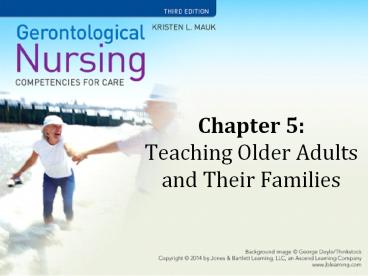Chapter 5: Teaching Older Adults and Their Families - PowerPoint PPT Presentation
Title:
Chapter 5: Teaching Older Adults and Their Families
Description:
Title: Chapter 5:Therapeutic Communication Author: jimmauk Last modified by: Molly Created Date: 7/6/2005 12:07:07 PM Document presentation format – PowerPoint PPT presentation
Number of Views:82
Avg rating:3.0/5.0
Title: Chapter 5: Teaching Older Adults and Their Families
1
Chapter 5 Teaching Older Adults and Their
Families
2
Learning Objectives
- Apply key principles of adult learning to
teaching older adults. - Discuss how changing demographics of the United
States influences various aspects of the
teachinglearning process. - Describe settings where health education for
older adults can take place. - Describe the influence of cultural diversity on
learning styles of older adults.
3
Learning Objectives (contd)
- Discuss how health literacy influences teaching
strategies used when educating older adults. - Compare the effect of normal physiologic changes
and chronic illness on the learning process. - Apply strategies for enhancing teaching and
learning of older adults.
4
Health Promotion and Illness/Injury Prevention
- Healthy People 2020 Federal initiative that
identifies health objectives relevant to older
people (Table 5-1, p. 124-125) - The Patient Protection and Affordable Care Act
of 2010 provides specific benefits to Medicare
recipients including educational interventions - Factors influence learning motivation and
ability educational levels, gender roles, work
experience, cultural/spiritual values, physical
health - Gerontological Nursing identifies Scope and
Standards to include health education of
patients, their families in their practice. - .
5
Principles of Adult Learning
- GI Bill of Rights sent millions of veterans to
college, changing peoples thinking about adult
learning and introducing the concept of lifelong
learning. - As baby boomers retire, many will return to the
workforce full- or part-time, which may increase
the need for new formal and informal educational
options for adults
6
Theory of Adult Learning
- Malcolm Knowles theory of adult learning.
- Theory used in the development, planning and
implementation of adult educational programs - Identifies motivation and relevance as key
concepts in adults learning - Androgogy the unique characteristics of teaching
and learning of adults
7
Theory of Adult Learning
- Adults
- expect respect for their abilities and experience
- are autonomous, self-directed, independent
learners - are goal oriented
- need to know that what they are learning is
relevant and practical to their daily lives - expect to actively participate in learning and
build on previous life experiences - derive much of their self-identity from past
experiences
8
Theory of Self Efficacy
- People's beliefs about their capabilities to
produce designated levels of performance that
exercise influence over events that affect their
lives - Older adults can learn to compensate for declines
in physical health by maximizing their
intellectual capabilities of increased knowledge,
skill, and experience.
9
Theory of Self Efficacy
- Gerogogy
- Definition the process involved in stimulating
and helping older persons to learn - teaching strategies leading to higher levels of
empowerment and emancipation - Older adults can benefit from adjustments to
teaching methods that consider impairments in the
sensory, psychomotor, cognitive, and affective
learning domains
10
Learning Preferences of Older Adults (Box 5-1,
5-2, P. 130)
- Easy access, small investments of time and money
to get started, and learning begins immediately. - Direct, hands-on experiences (Box 5-2)
- Methods that enable them to keep up with whats
going on in the world, for their own spiritual or
personal growth, and/or for the simple joy of
learning something new - Subjects that improve quality of life, build on
current skill, or enable them to take better care
of their health. - Use what they have learned right away or in the
near future.
11
Barriers to Older Adults Learning
- Health disparities (Box 5-3, p. 132)
- Factors related to cultural diversity
- Readability of materials for older adults
- People who have low health literacy may have
greater difficulty in locating providers and
service, filling out complex health forms,
sharing their medical history, seeking preventive
health care, managing chronic health conditions,
and understanding directions on medicine.
12
Technology for Older Adults Lifelong Learning
- 70 of those age 5064 and 38 of adults 65 use
the Internet - Half of Internet users between ages 50-64 and 26
of users 65 used social networking sites - Seniors learn to use computer technology at
public libraries, learning centers, and
businesses that sell electronic devices. - Table 5-3, p.137
13
Strategies for Teaching Older Adults (Box 5-8,
P.143)
- Use the principles of adult learning theory
- Use multiple teaching modalities to keep the
material interesting and maintain attention - Accommodate any unusual physical needs
- Make presentations elder-friendly
- Choose interesting content
- Use principles of literacy and avoid jargon
14
Strategies for Teaching Older Adults
- Avoid glare control environmental temperature
and noise level - Use micro phone and speak slowly
- Face the audience as many elders lip read
- Limit content to 30-40 minutes
- Handouts should be in large font.
- Make sure the room is large enough and prepare
adaptive equip. - Use low pitch voice
- Use non-verbal gesture
- Give enough time during break
- Provide liquid refreshment during break
15
Summary
- Nurses need to be
- prepared to meet the unique educational needs of
the growing population of older adults who
increasingly reflect diversity - flexible and adaptable, provide accurate and
reliable Internet resources, include families in
the instructional setting, consider the physical,
cognitive, and sensory changes that occur with
normal aging, as well as chronic disease states,
and adapt educational programs and materials to
the unique needs of older adults.































